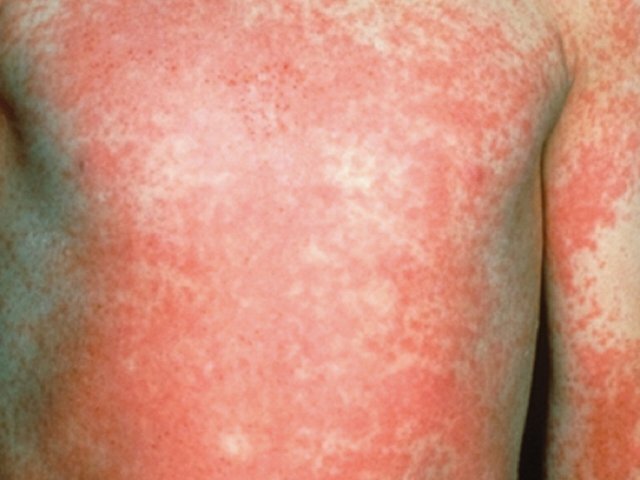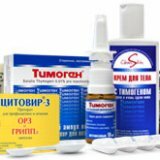Treatment of seborrheic dermatitis

Seborrheic dermatitis is a chronic skin disease caused by the fungus Pityrosporum ovale.The pathological process occurs in those parts of the skin that contain large sebaceous glands.The disease is characterized by a recurrent course.Seborrheic dermatitis is aggravated in winter, and in summer, symptoms often disappear.
Contents: What happens to the sebaceous glands?Causes for the development of the disease Symptoms of the disease Seborrheic dermatitis of the face Seborrheic dermatitis of the trunk Seborrheic dermatitis of the scalp Dry type of dermatitis Fatty type of dermatitis Inflammatory type Generalized seborrheic dermatitis Treatment Medication Nontraditional methods of treatmentWhat happens to the sebaceous glands?
The sebaceous glands are scattered throughout the body unevenly.So, the skin of the face, as well as the scalp, chest, interscapular area contains a large number of glands.And the skin of the feet and palms does not contain them at all.
The function of these glands is the production of sebum.The greasy secret lubricates the skin and hair, thereby softening them and protecting them from the effects of unfavorable external factors.
Fungus Pityrosporum ovale is an optional skin dweller, concentrating near the ducts of the sebaceous glands.When, under the influence of certain factors, the protective properties of the skin decrease, this leads to an increase in the reproduction of the fungus.Pityrosporum ovale splits sebum to free fatty acids, which it then uses to maintain its vital functions.
But the peculiarity is that free fatty acids have an irritating effect on the skin.So an inflammatory reaction is formed.In addition, in the pathogenesis of the disease, qualitative and quantitative changes in the production of sebum play a role.
Reasons for the development of the disease
Pityrosporum ovale fungus lives on the skin of every person, but seborrheic dermatitis develops only in some people.Why is this happening? Many factors, such as:
- , can activate fungal growth and trigger the disease. Stress.
-
 Endocrine disorders: pathology of the thyroid gland, adrenal gland, ovaries.To increase secretion of the sebaceous secretion leads to an increase in the level of androgens and a decrease in estrogens in the body.
Endocrine disorders: pathology of the thyroid gland, adrenal gland, ovaries.To increase secretion of the sebaceous secretion leads to an increase in the level of androgens and a decrease in estrogens in the body. - Physiological changes in the hormonal background in adolescence, during pregnancy, in the premenstrual period.
- Diseases of the nervous system: epilepsy, Parkinson's disease, autonomic dysfunction.
- Mental diseases.
- Immunodeficiency states.
- Diseases of the digestive tract.
- Accepting certain medications: neuroleptics, glucocorticosteroids, oral contraceptives, anabolic drugs.
- Defective food: abuse of spicy, spicy, carbohydrate food, and lack of vitamins and minerals.
Symptoms of the disease
Most often, seborrheic dermatitis is seen on the skin of the face, the scalp, and also the eyebrows and eyelashes.A bit less often the disease is affected by the BTE, chest, interblade area.Even more rarely are affected skin folds.
The following types of seborrheic dermatitis are distinguished:
- Seborrheic dermatitis of the face;
- Seborrheic dermatitis of the trunk and skin folds;
- Seborrheic dermatitis of the scalp:
- Dry type;
- Bold type:
- Inflammatory type.
- Generalized seborrheic dermatitis.
Seborrheic face dermatitis
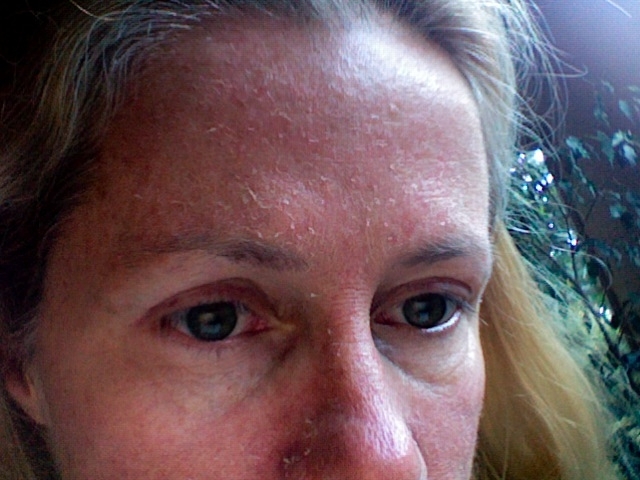 In the forehead, nose, nasolabial triangle, chin area, reddening areas with distinct edges appear.The skin peels, itches.Gradually, the spots begin to become covered with yellowish scales, which are formed as a result of impregnation of skin cells with a sebaceous secret.At the initial stage, small, whitish scales are noted.But with abundant flaking, the scales become larger, yellow.They can merge with each other, thereby forming large surfaces.Closure of scales occurs during infection.
In the forehead, nose, nasolabial triangle, chin area, reddening areas with distinct edges appear.The skin peels, itches.Gradually, the spots begin to become covered with yellowish scales, which are formed as a result of impregnation of skin cells with a sebaceous secret.At the initial stage, small, whitish scales are noted.But with abundant flaking, the scales become larger, yellow.They can merge with each other, thereby forming large surfaces.Closure of scales occurs during infection.
For seborrheic dermatitis complicated by a bacterial infection, a polymorphic rash is characteristic.Along with redness and scaling, papules and vesicles appear, usually located in the center of the plaque.At representatives of a male in the field of a mustache, beards pustules can arise.
Cutaneous fat can clog the ducts of the sebaceous glands.As a result, the contents of the duct stagnate and soon become infected.So there are blackheads.
The pathological process can also affect the eyelids.In this case, develops seborrheic blepharitis, which is characterized by redness, swelling of the eyelids, the appearance of cracks.On the edge of the eyelashes, scales are observed, because of which a person often clashes eyes in the morning.
Seborrheic dermatitis of the trunk
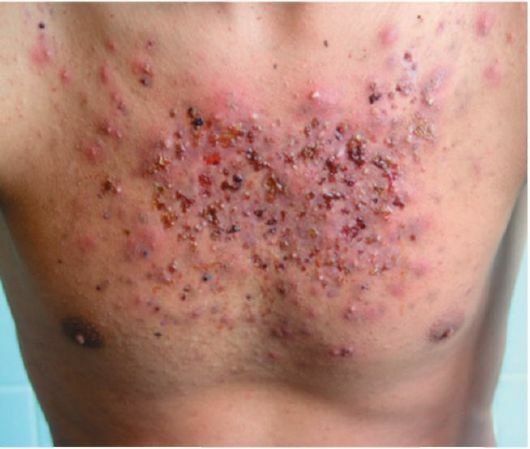
Foci of seborrheic dermatitis are formed on the chest and in the interblade area.Eruptions are mainly pink or yellowish papules covered with scales.As a result of their fusion, large seborrheic plaques form.They gradually increase, have clear outlines, while the skin in the center of the plaque can take a natural, healthy appearance, and on the periphery there are papules.Thus, plaques can become ring-shaped.When attaching bacterial infection, acne can appear on the skin.These formations often become inflamed and become painful.
In large skin folds( axillary, inguinal, under the mammary glands) there are clearly limited peeling erythema or plaques of pink or even dark red.Cracks and crusts can form on the surface of the seborrheic focus.
Seborrheic dermatitis of the scalp
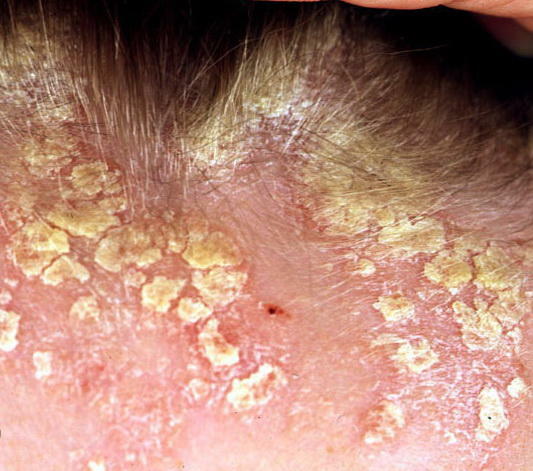
The main symptom of this form of the disease is the appearance of dandruff.Skin cells are constantly updated.The cycle of natural exfoliation of epidermal cells lasts an average of a month.But with a high activity of the fungus, this cycle is reduced to just one week, while the exfoliated cells do not have time to go through the stage of dehydration.
This leads to the appearance of a large number of flakes( dandruff) covering the head, which are visible to the naked eye.
Dry type of dermatitis
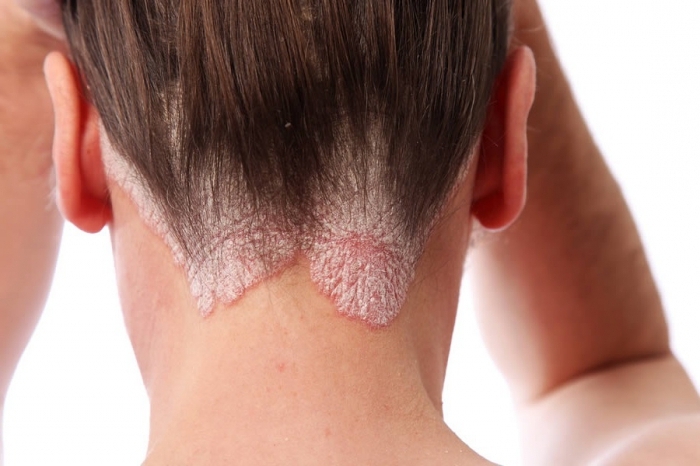 Dandruff appears as foci with predominant localization in the occipito- parietal region.Occasionally spreads over the entire head.The boundaries of the hearth are not clear.For this type of seborrheic dermatitis, the hypersecretion of the sebaceous glands is not characteristic.Therefore, the scales are small, friable, grayish-white in color.When rubbing the head, profuse dandruff easily falls on the shoulders, clothes.The hair is also dry.
Dandruff appears as foci with predominant localization in the occipito- parietal region.Occasionally spreads over the entire head.The boundaries of the hearth are not clear.For this type of seborrheic dermatitis, the hypersecretion of the sebaceous glands is not characteristic.Therefore, the scales are small, friable, grayish-white in color.When rubbing the head, profuse dandruff easily falls on the shoulders, clothes.The hair is also dry.
Bold type of dermatitis
This type of disease occurs with increased production of a sebace secret.Scales have a greasy, waxy appearance, glued together, yellow.Scales are densely attached to the scalp, rather than with a dry type of dermatitis.When rubbing the head, dandruff is separated ungainly by large flakes.Hair quickly zhirneyut, look greasy, stuck together.On the surface of the skin, foci of redness are observed.Because of skin itching, a person can comb his head.As a result, excoriations occur on the scalp of the scalp.
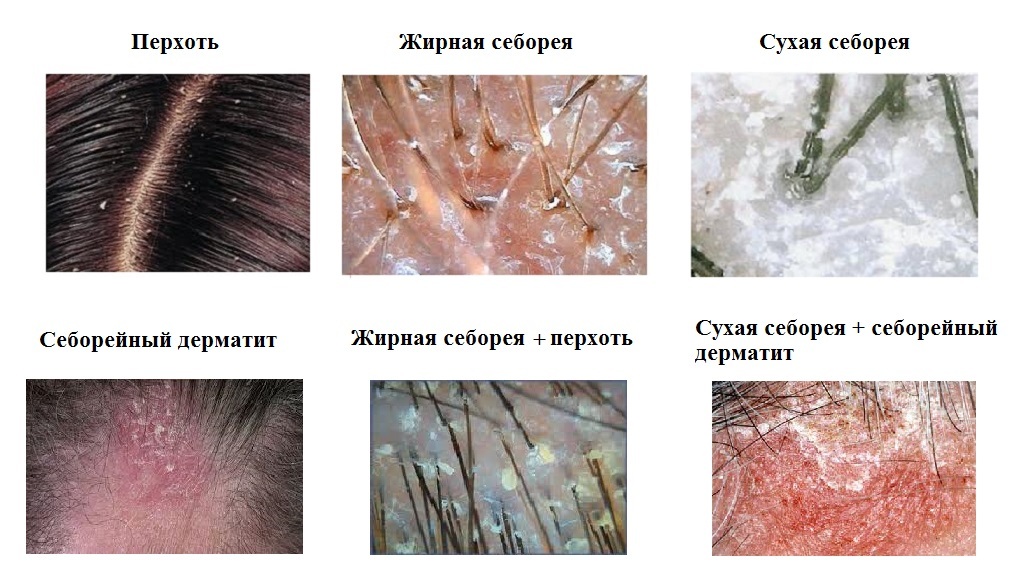
Inflammatory type
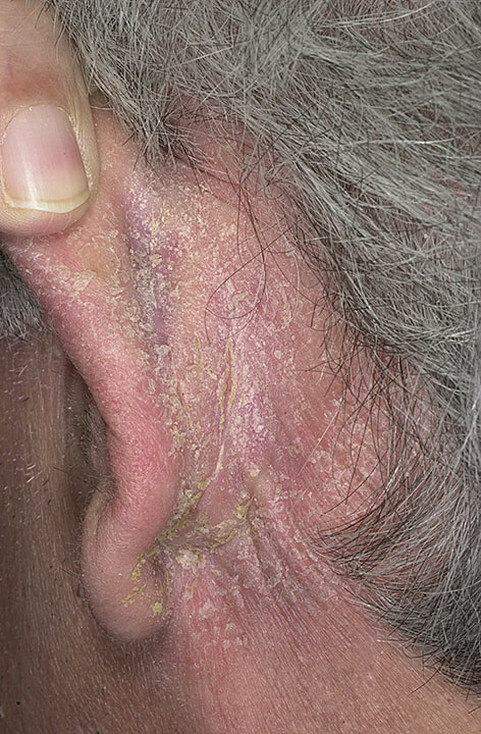 This type of dermatitis is characterized by the fact that on the scalp arises peeling erythema with clear edges.Seborrhea plaques can merge into whole foci that cover the entire scalp.On the surface of the plaques there are whitish or yellow scales.There is also a characteristic feature of the seborrheic corona.This is clearly delineated rashes that appear on the border of the forehead and the scalp.When the inflammatory type of a person's dermatitis is concerned, a pronounced itch of the head.
This type of dermatitis is characterized by the fact that on the scalp arises peeling erythema with clear edges.Seborrhea plaques can merge into whole foci that cover the entire scalp.On the surface of the plaques there are whitish or yellow scales.There is also a characteristic feature of the seborrheic corona.This is clearly delineated rashes that appear on the border of the forehead and the scalp.When the inflammatory type of a person's dermatitis is concerned, a pronounced itch of the head.
Some people on the surface of seborrheic foci appear purulent yellowish-gray crusts that have an unpleasant smell.It is characteristic that after removing the crusts, a wetting surface is observed.
Often, the dermatitis passes to the neck, ear and behind-eye area, forehead.In the folds behind the ears are formed deep painful cracks.In rare cases, there is an increase in local lymph nodes.
Generalized seborrheic dermatitis
Increasing and confluent seborrheic foci can lead to the development of secondary erythroderma.The skin acquires a pink color, sometimes with a yellow or brown tinge, becomes swollen, cracks, wetness, and scaling appear on its surface.
Often, candida and piococcal flora are also involved in the pathological process.In such cases, the person raises the temperature, there is itching, overall health worsens.
The generalized form of seborrheic dermatitis often develops with HIV infection.
Treatment of
The fight against seborrheic dermatitis should begin with the discovery of the cause that caused the onset of the disease.If the cause can be found, it is necessary to address it.
Medical treatment
Etiotropic treatment consists in prescribing external antimycotic drugs acting on Pityrosporum ovale. These preparations include :
- Azoles( ketoconazole);
-
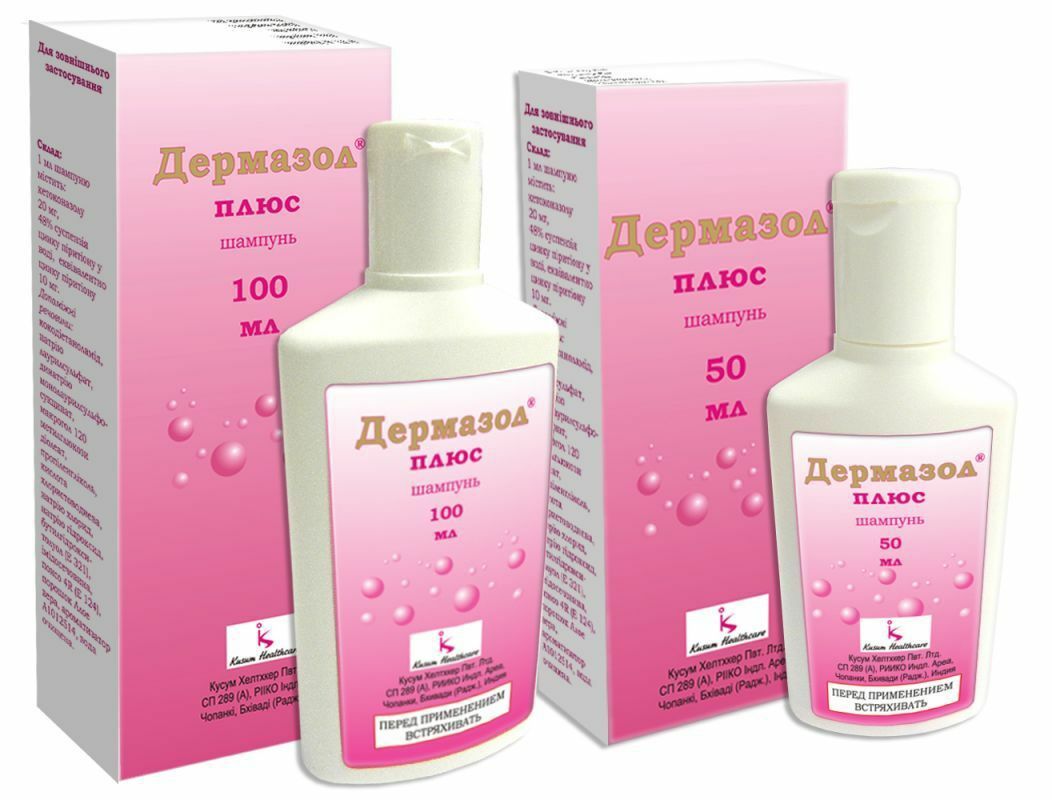 Terbinafines( Lamisil);
Terbinafines( Lamisil); - Olamines( Batrafen);
- Derivatives of amorolfine;
- Preparations of zinc( Kuriozin, Regecin);
- Preparations containing sulfur( selenium disulphide);
- Preparations containing tar;
- Preparations containing Ithiol.
For the treatment of smooth skin, these medicines are prescribed in the form of ointments, gels, creams.In cases where seborrheic dermatitis is complicated by pyogenic flora, antibiotics containing creams are prescribed( eg, Baneocin, Fucidine).In the inflammatory type of the disease, ointments, emulsions, creams containing glucocorticosteroids( Elokom, Lokoid) are prescribed.In addition, with seborrheic dermatitis apply keratolytics in small concentrations( resorcinol, salicylic acid).
For dermatitis of the scalp, the above listed products are prescribed in the form of shampoos.Use them twice a week.And the whole course of treatment can be 8-9 weeks.
Please note: should be allowed to wait for five to ten minutes after applying an antifungal shampoo.So, the active substances of shampoo will have time to produce a positive effect.And only after a specified period of time you can wash off the product from the head.
When dry type of disease should be avoided means that overdry the skin.Alkaline shampoos, soaps, as well as alcohol-containing products have a similar effect.
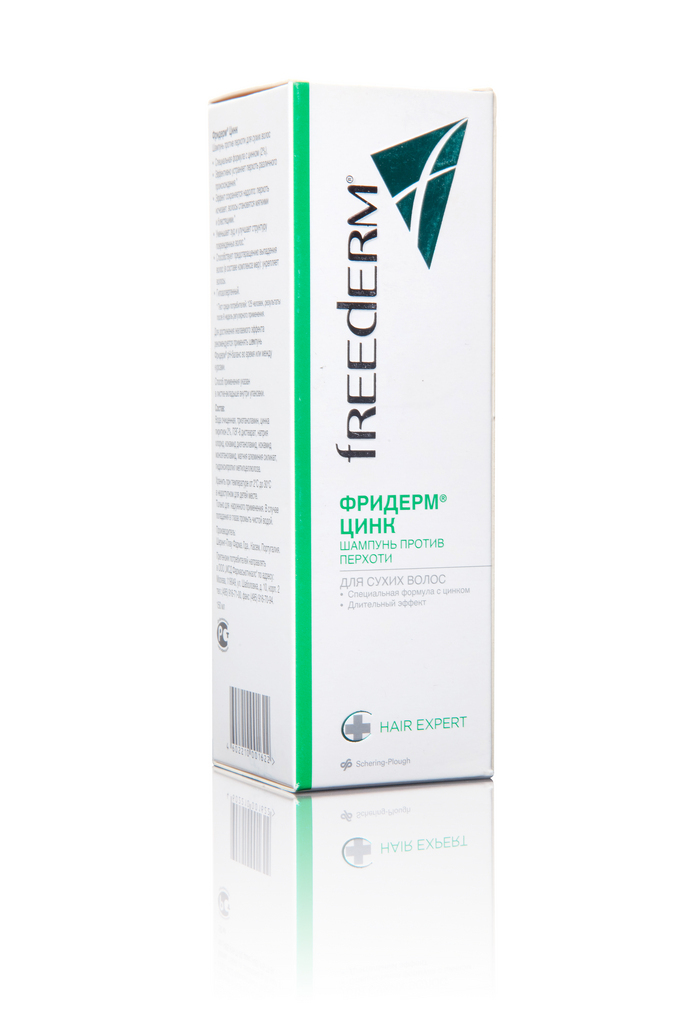 For the treatment of dry type dermatitis shampoos are the most suitable:
For the treatment of dry type dermatitis shampoos are the most suitable:
- Azola containing( Nizoral, Sebozol);
- Zinc-containing( "Friederm-zinc");
- Sulfur-containing( "Silezhel", "Sulsena").
In case of a fatty type of dermatitis it is recommended to use antiseboric agents containing acids, anionic and cationic detergents.
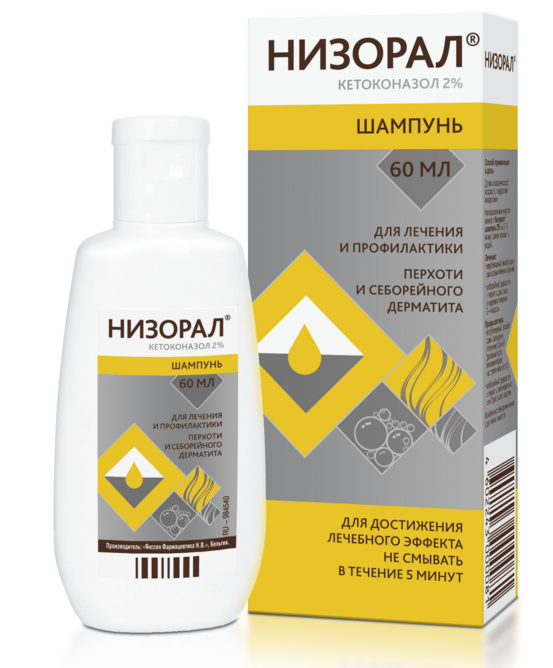 The most suitable shampoos :
The most suitable shampoos :
- Azola containing( Nizoral, Sebozol);
- Containing tar( "Friederm-tar");
- Containing ichthyol( "Curtiol");
- Sulfur-containing( "Sulsena").
After reaching remission, you should wash your head with an antifungal shampoo once every two weeks.And the rest of the time, a mild shampoo with a neutral ph will do.
For severe, generalized seborrheic dermatitis, antifungal drugs( ketoconazole) and steroids( prednisolone) may be given in tablets.In cases involving secondary infection, broad-spectrum antibiotics are indicated.
Treatment of seborrheic dermatitis with folk remedies
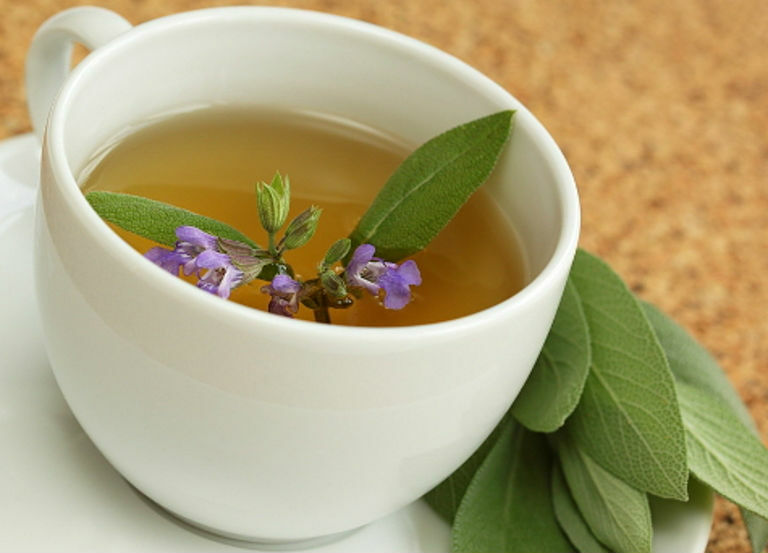 As ancillary methods, you can use traditional medicine recipes that can reduce the manifestations of the disease and eliminate itching.To this end, you can prepare a decoction of herbs.
As ancillary methods, you can use traditional medicine recipes that can reduce the manifestations of the disease and eliminate itching.To this end, you can prepare a decoction of herbs.
To prepare a decoction of sage, grind a tablespoon of herbs, and then pour a glass of boiling water.When the broth cools a little, you need to add a tablespoon of honey, and then strain the infusion.Obtained remedy should wipe the skin.This method is suitable for skin care with dry seborrheic dermatitis.
To combat fatty seborrheic dermatitis, you can use tincture with St. John's wort.In the prepared dishes, you should pour two glasses of alcohol and pour three tablespoons of chopped St. John's wort.The dishes should be covered with a lid and placed in a dark place for at least seven days.Before use, tincture must be diluted 1: 1 with water.The product is treated with affected skin in the morning.It is not necessary to abuse such tincture, as its long-term use can provoke dry skin.
Grigorova Valeria, medical reviewer

